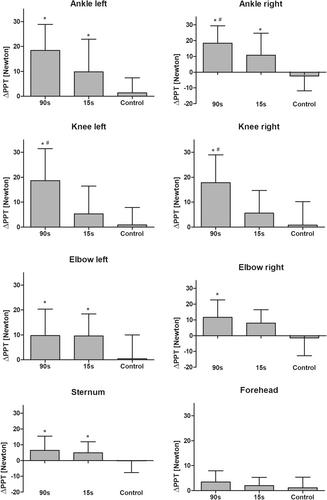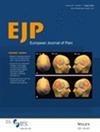Acute physical activity leads to exercise-induced hypoalgesia (EIH). However, to what degree it can be induced by very short but highly intensive exercise is largely unknown. This study aims to investigate the effects of two different short all-out isokinetic exercise sessions on EIH.
Twenty young male participants underwent three different interventions (90, 15 s all-out isokinetic cycling, respectively, and control) after an individualized low-intensity warm-up in a randomized-controlled-crossover design. Before (pre), after warm-up (post 1) as well as immediately post-intervention (post 2) pain sensitivity was measured employing pressure pain thresholds (PPT; in N) at the elbow, knee and ankle joints as well as the sternum and forehead. Performance parameters (e.g. lactate, perceived exertion, heart rate) were documented.
A ‘time’ × ‘intervention’ × ‘body site’ interaction effect (p < 0.001, η2 partial = 0.110) was observed for PPT. Both isokinetic interventions resulted in EIH at all body sites, even after ruling out any warm-up effects, while effects were larger for 90 s (maximum increase of 25.7 ± 11.7 N) compared to 15 s (maximum increase of 19.3 ± 18.9 N), and control (maximum increase of 8.0 ± 6.1 N). Compared to control, 15 s also resulted in hypoalgesic effects and differences were not observed at all sites. In this study, 90 s resulted in higher lactate, subjective exhaustion and heart rate levels compared to 15 s and control (p < 0.001), while higher values were also observed for 15 s compared to control.
Global EIH assessed immediately after exercise can be induced by short highly intensive exercises. The effects are greater when the subjective and the objective exertion are higher as induced by the 90 s intervention.
This study investigates the potential for brief, highly intensive exercise sessions to induce exercise-induced hypoalgesia (EIH). The research demonstrates that EIH can indeed be triggered by such short workouts, with greater effects observed during a 90 s session compared to a 15 s one, most likely due to higher subjective and objective exertion. These findings offer insights into the potential for extremely brief but intense exercises to alleviate pain, impacting exercise recommendations and pain management strategies.



